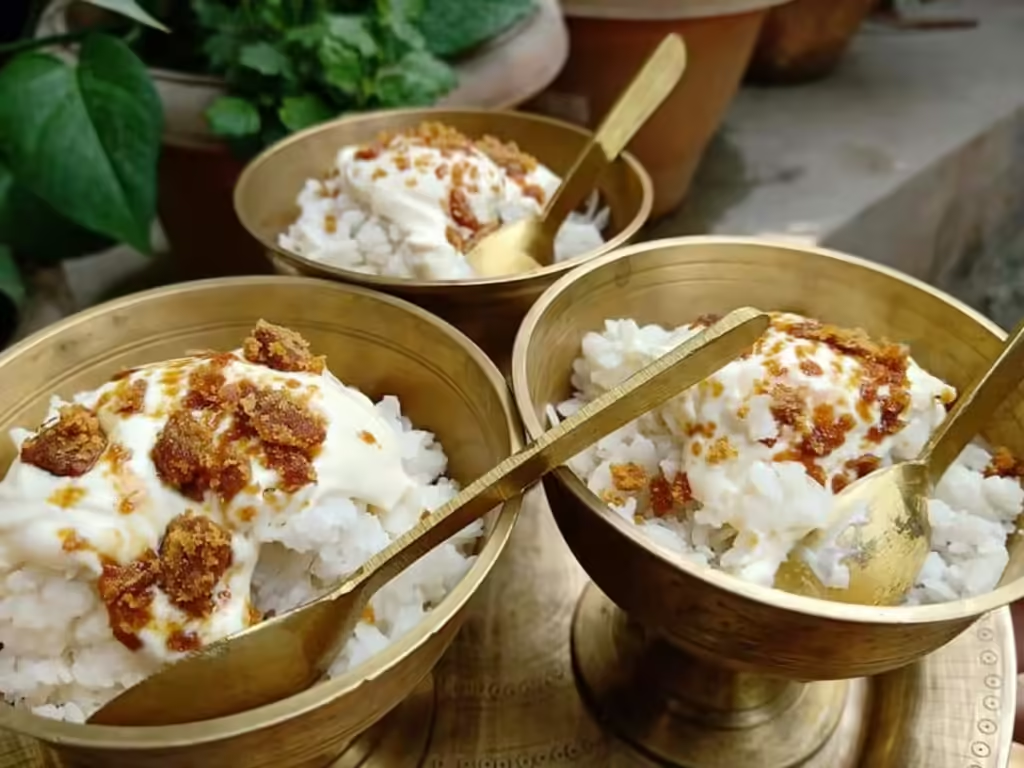Jolpan, a popular light meal or snack in Assam, typically includes different varieties of rice such as roasted and ground rice (xandoh), flattened rice (chira), puffed rice (muri), komal saul, or cooked sticky rice (bora saul). These are commonly enjoyed with curd or cream and sweeteners like jaggery. Flattened rice (Bora Dhan’s Cira) is often paired with cream and is a sweet alternative to jaggery.
Jolpan is a versatile dish in Assamese cuisine, often served for breakfast but also enjoyed during special occasions like Bihu festivals, weddings, and other gatherings. The term “jolpan” covers a range of dishes, including pitha, laddu, and tea. One unique aspect of these rice varieties is that some can be eaten without cooking—simply by soaking them. They are generally served with curd (doi), jaggery (goor), or assorted pitha. Jolpan is also found in Bengali cuisine. The word originally comes from “water and betel leaf,” but it has come to mean any type of light snack.
History and Cultural Significance of Jolpan
Historical Background: Jolpan, a traditional Assamese breakfast, has roots that stretch back centuries. It originated as a simple, nutritious meal for farmers and laborers, providing them with the energy needed for a day’s work. Over time, Jolpan evolved into a cherished part of Assamese culinary heritage, symbolizing the region’s agricultural abundance and cultural richness.
Cultural Importance: Jolpan plays a vital role in Assamese festivals and celebrations. During Bihu, the most significant festival in Assam, Jolpan is a staple. It is served to guests as a gesture of hospitality and is an integral part of the festive breakfast. At weddings, Jolpan is often included in the traditional breakfast spread, symbolizing prosperity and well-being. Its presence in these events underscores its importance in Assamese social and cultural life.
Personal Stories: Many Assamese people have fond memories of Jolpan. For instance, Rina, a local from Jorhat, recalls her grandmother preparing Jolpan every morning with freshly harvested rice and homemade curd. “It was more than just food; it was a way to start the day with love and warmth,” she says. Similarly, Raj, another local, shares how Jolpan was a highlight of his childhood Bihu celebrations, bringing the family together around the breakfast table. These personal stories highlight the emotional and cultural significance of Jolpan in Assamese households.
Types of Jolpan
Bora Saul: Bora Saul is a sticky rice variety known for its chewy texture and sweet flavor. It’s typically soaked overnight and then steamed or boiled. This rice is often enjoyed with curd and jaggery, making it a comforting and nutritious breakfast option.
Komal Saul: Komal Saul is a unique type of rice that doesn’t require cooking. It is soaked in water for a few hours until it softens and is then ready to eat. This rice is often paired with milk, curd, or jaggery, providing a quick and easy meal that’s both delicious and filling.
Xandoh: Xandoh is made by grinding Bora Saul into a coarse powder. This powder is then mixed with water or milk to create a porridge-like dish. Xandoh can be sweetened with jaggery or sugar and is often flavored with cardamom or other spices, making it a versatile and hearty breakfast.
Chira: Chira, or flattened rice, is prepared by parboiling rice and then flattening it into thin flakes. These flakes can be eaten raw, soaked in milk, or lightly fried. Chira is incredibly versatile and can be used in both sweet and savory dishes, making it a staple in many Assamese households.
Muri: Muri, or puffed rice, is made by heating rice kernels until they puff up. This light and airy rice is often mixed with jaggery, peanuts, and coconut to create a delicious snack. Muri is also a key ingredient in various Jolpan dishes, adding a delightful crunch.
Sunga Saul: Sunga Saul is a traditional preparation method where rice is cooked inside bamboo tubes. The bamboo imparts a unique flavor to the rice, making it aromatic and slightly smoky. This method is often used during special occasions and festivals, adding a touch of tradition and authenticity to the meal.
Ingredients and Preparation

Common Ingredients: Jolpan is a delightful blend of various types of rice and accompaniments. The main ingredients include:
- Bora Saul: A sticky rice variety.
- Komal Saul: A unique rice that softens without cooking.
- Xandoh: Ground roasted rice.
- Chira: Flattened rice.
- Muri: Puffed rice.
- Curd (Doi): Fresh, homemade curd.
- Jaggery (Goor): Unrefined sugar made from sugarcane or palm.
- Pitha: Traditional Assamese rice cakes.
Preparation Methods:
- Bora Saul:
- Soak: Rinse and soak Bora Saul overnight.
- Cook: Boil or steam until soft.
- Serve: Pair with curd and jaggery.
- Komal Saul:
- Soak: Rinse and soak Komal Saul in water for a few hours.
- Serve: Drain and mix with milk or curd, and sweeten with jaggery.
- Xandoh:
- Grind: Grind Bora Saul into a coarse powder.
- Mix: Combine with water or milk to form a porridge.
- Flavor: Sweeten with jaggery and add spices like cardamom.
- Chira:
- Soak: Rinse and soak Chira for a few minutes.
- Serve: Mix with curd and jaggery, or lightly fry with spices for a savory twist.
- Muri:
- Puff: Heat rice kernels until they puff up.
- Mix: Combine with jaggery, peanuts, and coconut for a crunchy snack.
- Sunga Saul:
- Prepare Bamboo: Clean and cut bamboo tubes.
- Fill: Stuff the tubes with soaked rice and water.
- Cook: Roast over an open flame until the rice is cooked and infused with bamboo flavor.
Nutritional Benefits
Health Benefits: Jolpan is packed with nutritional goodness, thanks to its wholesome ingredients. Different types of rice like Bora Saul and Komal Saul are rich in carbohydrates, providing a steady source of energy. Curd is an excellent source of probiotics, which aid in digestion and boost the immune system. Jaggery, a natural sweetener, is rich in iron and minerals, making it a healthier alternative to refined sugar. Pitha, made from rice and coconut, adds fiber and essential fats to the diet. Overall, Jolpan offers a balanced mix of macronutrients and micronutrients, making it a nourishing start to the day.
Dietary Considerations: Jolpan can be tailored to suit various dietary needs. For those looking for a gluten-free option, Jolpan is ideal as it primarily consists of rice and rice-based products. It’s also a great choice for vegetarians, providing essential nutrients without any animal products. The inclusion of curd adds a good dose of protein and calcium, beneficial for bone health. For those watching their sugar intake, the natural sweetness of jaggery can be a healthier substitute. Additionally, the high fiber content from ingredients like Chira and Muri helps in maintaining digestive health and keeping you full for longer periods.
Serving and Presentation
Traditional Serving Methods
In Assamese households, Jolpan is often served with great care and simplicity, reflecting the region’s rich cultural heritage. Here are some traditional methods:
- Bamboo Platters: Jolpan is traditionally served on banana leaves placed over bamboo platters. This not only enhances the aesthetic appeal but also adds a subtle flavor to the food.
- Earthenware Bowls: Using earthenware bowls for serving Jolpan is common. These bowls keep the food cool and fresh, especially important for dishes served with curd.
- Festive Occasions: During festivals like Bihu, Jolpan is served with additional accompaniments like pitha (rice cakes) and laru (sweet balls), making it a festive delight.
Modern Twists
While traditional methods are cherished, contemporary ways to serve Jolpan can add a fresh twist:
- Mason Jars: Serving Jolpan in mason jars can make it portable and visually appealing. Layers of different rice types, curd, and jaggery create a beautiful presentation.
- Fusion Bowls: Combining Jolpan with fruits, nuts, and honey can add a nutritious and modern twist. This fusion bowl can be a perfect breakfast option.
- Dessert Cups: Presenting Jolpan in small dessert cups with a drizzle of chocolate or caramel can make it an exciting dessert option for parties.
Visual Appeal
The visual appeal of Jolpan can be enhanced with thoughtful presentation. Here are some ideas:
- Colorful Layers: Use different types of rice like chira (flattened rice), muri (puffed rice), and xandoh (roasted rice) to create colorful layers in a glass bowl.
- Garnishes: Garnish with fresh fruits, mint leaves, or edible flowers to add a pop of color and freshness.
- Plating: Arrange the components of Jolpan neatly on a plate, with small bowls of curd and jaggery on the side, to create an inviting and appetizing look.
Conclusion
Assamese Traditional Jolpan” encompasses a wide variety of light snacks and breakfast dishes that hold a special place in Assamese cuisine and culture. These dishes, often made from locally sourced ingredients like rice, puffed rice, flattened rice, lentils, and jaggery, reflect the simplicity, diversity, and rich agricultural heritage of Assam. Jolpan is more than just food; it represents the traditions, hospitality, and warmth of the Assamese people. Whether served during festivals, family gatherings, or as a daily morning ritual, Jolpan symbolizes a connection to one’s roots and the passing down of culinary practices through generations. Preserving these traditional dishes is vital for maintaining Assam’s cultural identity and showcasing the region’s unique flavors to the world.
FAQ’s
Q. What is Jolpan in Assamese cuisine?
A: Jolpan refers to a variety of traditional Assamese breakfast dishes and snacks made from rice, flattened rice, puffed rice, lentils, and jaggery. These dishes are usually light and are often accompanied by curd, milk, or jaggery.
Q. What are some popular types of Jolpan?
A: Some popular types of Jolpan include chira doi gur (flattened rice with curd and jaggery), muri ghuror pitha (puffed rice with molasses), sandoh guri (a type of rice flour), komal saul (soft rice with curd), and pithas (traditional rice cakes).
Q. Can Jolpan be considered healthy?
A: Yes, Jolpan is generally considered healthy as it is made from natural and locally sourced ingredients. The dishes are low in fat and rich in fiber, providing a nutritious start to the day. However, the addition of jaggery and milk adds natural sweetness and nutritional value.












